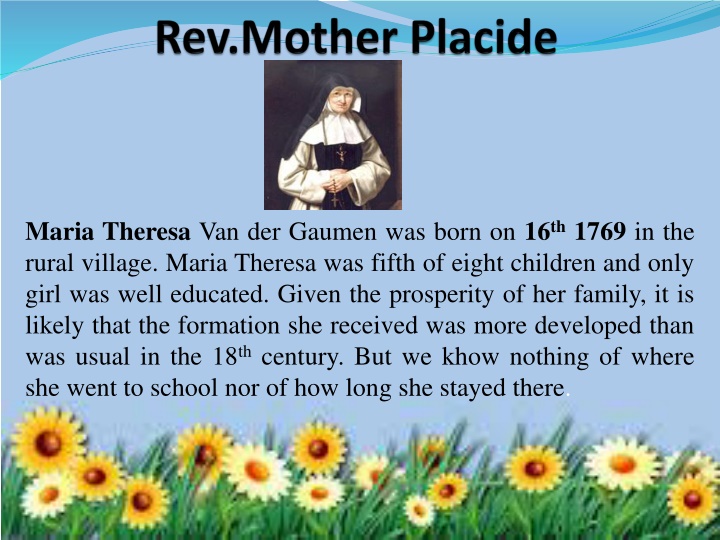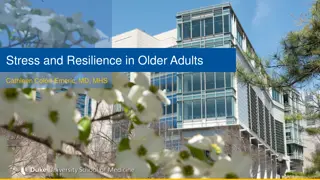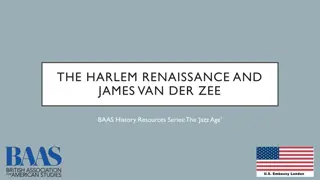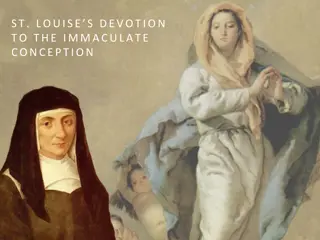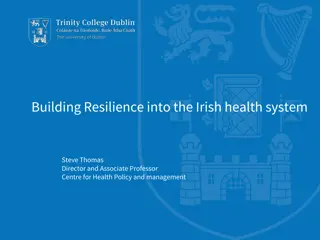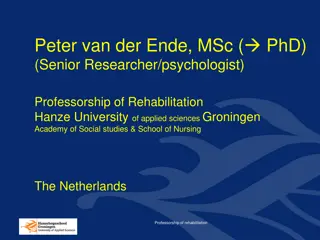The Journey of Maria Theresa Van der Gaumen: A Tale of Devotion and Resilience
Maria Theresa Van der Gaumen, born in 1769, faced early tragedy with the loss of her mother, becoming the sole woman managing her family's estate at a young age. Despite challenges and political turmoil, Maria held onto her dream of religious life. Eventually, in 1804, she found her calling and joined the Congregation of the Sisters of Charity, led by Father Triest. Maria's story is one of strength, perseverance, and unwavering faith in the face of adversity.
Download Presentation

Please find below an Image/Link to download the presentation.
The content on the website is provided AS IS for your information and personal use only. It may not be sold, licensed, or shared on other websites without obtaining consent from the author.If you encounter any issues during the download, it is possible that the publisher has removed the file from their server.
You are allowed to download the files provided on this website for personal or commercial use, subject to the condition that they are used lawfully. All files are the property of their respective owners.
The content on the website is provided AS IS for your information and personal use only. It may not be sold, licensed, or shared on other websites without obtaining consent from the author.
E N D
Presentation Transcript
Maria Theresa Van der Gaumen was born on 16th 1769 in the rural village. Maria Theresa was fifth of eight children and only girl was well educated. Given the prosperity of her family, it is likely that the formation she received was more developed than was usual in the 18th century. But we khow nothing of where she went to school nor of how long she stayed there.
Mother Placides life A novice in the Abbey of Maagdendale A novice in the convent of Maagdendale from which she was expelled because of the French Revolution . We can find no record of when Maria Theresa entered the Cistercian abbey of Maagdendale nor of when she left. It seems likely that she entered in 1790. A letter was written by her uncle priest Jan Baptiste with her massage of the abbess who advised all the novices to return home. At that time Maria Theresa was 23 year old and according to the law nobody could make any vows before the age of 25. In 1794 just two years after her return home, her mother died and she found herself the only woman on the farm. She took over the running of the house and property with the help of servant.
New Religion Trends Maria Theresa was most probably aware of the existence of this New Current she was certainly in contact with her uncle, Jan Baptiste. It remains an open question whether she had ever, in the years after 1792, conceived the idea of joining one of these young congregations. In the first year it seems probably that she hoped, once peace was restored to the land, to be able to return to the Abbey of Maagdendale. After the death of her mother, in 1794, she was taken up with family obligation. When, in 1796, the nuns in Maagdendale were expelled and, in 1797 the Abbey itself was sold, she must have given up all hope of living a Cistercian life.
After Maagdendale, Lovendegem In 1804 Maria Theresa was thirty-five old. It seems likely that she had never stopped dreaming about religious life, and since her first choice was impossible she was looking out her another congregation. Even after the death of her uncle Jan Baptiste in 1798, she must surely have followed these new foundations, together with the thinking behind them and their struggles. It is quite possible that she and Peter Triest knew each other. We have no direct proof of this, but during the years of persecution Fr. Triest like Maria Theresa s priest brother went underground . This finally persuaded Maria Theresa in May 1804 to join the small group of women that was later to develop into the Congregation of the Sisters of Charity.
Profession She decided to take a new orientation and knocked at the door of the little house of Lovendegem in order to be admitted in the community that Father Triest had just founded. She was a woman in the strength of the age; suffering had matured her and her character was hardened. Since it was impossible for her to return to a monastery due to the political situation, she made this decision decisive both for life and for ours.
Two months later, on the 2 July 1804, she made profession and took the name of Placide, contrary to her companions who kept their baptismal name. No doubt, as Sister Theresa writes, by taking a name of the Benedictine tradition (Placide contemporary monk of St Benedict in Sicily Sister expressed already some hope, namely to restore the tradition of monastic religious life which was brutally interrupted by this great upheaval of the modern times that was the French Revolution. Having become the corner stone of this congregation, this strong and discrete woman will play a determining role; not only in the choice of our life style, but also in the many foundations of the first period. It is thus that, undoubtedly counseled by the Bishop of Ghent and his canonists, and especially by Fr. Triest, she has made for us an original choice of religious life.
For her communities almost all of them were established in an urban area from 1805 onwards. She did not take on completely the fundamental rules of the Daughter of Charity nor the whole of the Cistercian customary. She opted for a going together of the two tendencies and of the two life styles.
Portrait and Spiritual Message of Mother Placide Even through the sources might be lacking, one can, thanks to several documents that are complementary, somewhat the personality and the spiritual message of Mother Placide.
Rules: First Fundamental Article The Sisters of Charity of Jesus and Mary, founded in the town and diocese of Ghent, united in the Sacred Heart of Jesus, under the protection of the Blessed Virgin Mary, St Vincent de Paul and St. Bernard, will join the contemplative life to the active life as far as their duties permit. Their active consists in serving the sick poor without discrimination, in their convents or in civil or military hospitals; in caring for the mentally deficient women, in educating orphans and other unfortunate young girls, in running schools, in a word in exercising all types of works of Charity according to the spirits and ruler of St Vincent De Paul.
At the beginning of the 19thCentury, it was necessary to fix some new points for religious life, taking into account the changing context; Mother Placide made the choice that imposed itself at this time. To the three pillars of the Benedictine tradition prayer work and fraternal life was joined for a certain time the vow of serving the poor sick and implicitly, a great concern of ascetics. Mother Placide was superior General for 38 years. She died on 28th September 1844, at the age of 75, after contribute to the foundation of 18 houses.
Symbolises the life of the SCJM Among these three crosses Mother Placide gives a prominent place to the cross of her rosary! Why? Only because it symbolises the life of the JCJM, namely its inspiration from the Gospel in the line of St Vincent De Paul On the ring we have engraved Cor Unum anima Unna sentence of the Acts of the Apostles, reminding us of the first Christian community, joining around the teaching of the apostles, the breaking of the bread, the prayer and of the sharing of goods. On one side of the cross Venite Benedicti Patris Mei, start of the episode of Matthew stating that those who have visiting their brothers, those who gave food and drink to them, those who have clothed their brother who are living in poverty, have done this to Jesus Himself and are called to enter into the joy of the Father..
(Let us not forget that Matthew 25 is the message that provided the word of life to Vincent when he had to determine his vocation.) And Pauperes evangelizanture (Matthew 11, 06) being part of Jesus answer to the messengers of John and revealing that Jesus is really the Messiah, because the sign of the Good News are being real (Word of God, also very close to the other word that turned the heart of Vincent: the Holy spirit has sent me to give the Good news to the poor.) On the other side of the cross: Caritas Christi urget nos (2 Cor 5, 14) words of St Paul inserted in a speech on the apostolic ministry and the 5th Beatitude of Luke.
Here as well, we see a clear allusion to Vincent De Paul. We can find back these sentences on paintings ordered by Vincent to be put in the the places where the first Ladies of Charity came together. We call these painting The Lord of the Charity because the image of Jesus was represented at the center of the painting while the scenes in which were presented the works of mercy , could be found on both side of the central person.
The Spiritual Testament of Mother Placide It is the most likely document of all documents which are attributed to Mother Placide. The document is written in the form of a small collection of spiritual maxims. It has always been attributed to our Mother Foundress First of all, we see seven maxims that she gave to her Sisters, at their request; maxims that are supposed to summaries the principal means of perfection. i. To surrender completely to God s will, things pertaining to the spiriting exercise. ii. Not to have too great a desire for feelings of consolation, but to be satisfied with the substance of devotion. In other words to have that courageous faith which leads the soul to do with joy whatever God asks iii. To do that has to be done without tiring oneself unnecessarily doing what God is not asking. iv. To distrust those passionate desires that can arise in the soul. They can be good, but they can also be opposed to the Divine will. Discernment will be the violence of emotion is past. v. Obey. vi. Love the Cross. vii. Be simple, open heart to God, live in Joy.
Joy In The Cross Let us consider the presence of the dimensions of the cross and the joy, both in this testament, and in this little text: I call the cross of Jesus in the three exclamations Long Live Jesus Long live cross! Long live joy! All messages that plunge us in the heart of the mystery of Jesus and of his Eater invite us to unceasingly these two dimensions of suffering death, failure on the one hand, and of resurrection, of life, of joy on the other hand; and this both in our spiritual life and our apostolic commitments. And it is really true that Francis who lives with the stigmata of Jesus in his body, while speaking about the PerfectWay made his own the Pascal dynamism Love the Cross this short text, this small phrase I call the Cross of Jesus explain it.
I call the cross of Jesus everything that causes suffering and that we have to accept from the hand of God with resignation, or better still with gratitude of love things such as persecution, contradiction, and work sickness the loss of friends and reputation, fear, scruples, towards spiritual things, indifference, attraction towards discouragement, temptation all misfortunes are the Cross of Jesus. desolation, evil, remorse, these
Mather Placides illness and death, 1842-1844 When the sister who kept the log book of Terhagen wrote about the esteem that Canon De Decker had for Mother Placide while she was Superior General, she showed that she shared his feeling: she was to be seen every morning at 4 0 clock at the head of her community in the chapel, even in the coldest winter days, and despite the fact that given her age her failing heath- she would be expected to rest more . This was before 1842, because from then on she does not seem to have taken part in the ceremonies of religious profession. Her name no longer features in register of the professions. It seems likely that she was sick during the last two years of her life.
On October 9th 1843 Mother Placide wrote about her health to Mother Borgia: And furthermore may you and your sisters remember me in your prayers for I am poorly, can hardly eat and am deteriorating . On September 28th 1844 death called Mother Placide from the affection of her sisters. For Canon De Decker too her death was a painful loss: He could only say Faith and bring this painful sacrifice to the foot of the Cross, in the expectation that Divine Providence will be pleased to let the sister choose a superior for the head of the Congregation who will be worthy to walk in the footsteps of Mother Placide . On her memorial card we find: For forty years she governed the association of Sisters of Charity with wisdom and moderation .
Mother Placides Will In June 1844 there were still more changes. The harvest had failed for several years running and the economic situation was so bad that many poor people were suffering from hunger. Probably moved by this, Mother Placide s decided that part of her property should go to the public welfare Office in her birthplace, Etikhove, three quarter of the income from the land was left for the upkeep of poor orphans and all people in need. From the remaining quarter she prescribed that, for the coming fifty years, five Masses were to be celebrated in the Church in Etikhove each year, for her parents, her brother and herself. It was widespread custom to make provision by will for prayers to be offered for the repose of one s own soul as well as for recently deceased members of the family. The greater part of her property remained as a bequest to the congregation, in the names of Sr. Perpetua and Sr. Kostka.
Mother Placides Funeral Thanks to the initiative of Canon De Decker, provision had been made for a cemetery for the sisters in the grounds attached to the house in the Lovendegem. A shrine was built there for the Superiors General. The cemetery and shrine had just been established when Mother Placide died on September 28th 1844. Canon De Decker consecrated the cemetery just the day before her funeral, and she was the first person to be buried there. Now six other Superiors General rests beside her, including Fr.Triest. Father Triest was first buried in the parish churchyard at Lavende.
Thank you!
